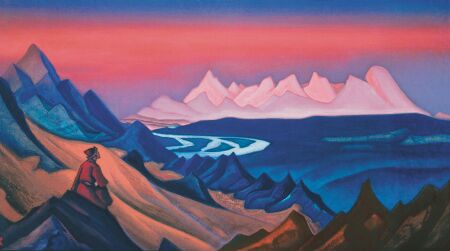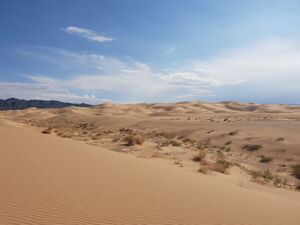Шамбала

Шамбала — древний дом Саната Кумары и Гаутамы Будды — расположена в эфирном царстве над пустыней Гоби. Эту Священнообитель, бывшую когда-то физической, затем удалили в эфирную октаву, то есть в небесный мир.
Establishment of the retreat
Изначально обитель была построена для Саната Кумары — иерарха Венеры, который пришел на Землю в ее самую темную эпоху, когда эволюции этой планеты утратили весь свет и здесь не осталось никого, кто бы поклонялся Бого-Присутствию, или Внутреннему Будде. Вместе с Санатом Кумарой для исполнения особой миссии пришел отряд из ста сорока четырех тысяч душ света, которые добровольно вызвались хранить пламя жизни от имени людей Земли. Эти души света дали обет делать это до тех пор, когда дети Бога, которых падшие ангелы увели от их первой любви, ответят на любовь Бога и снова начнут служить своему могущественному Я ЕСМЬ Присутствию.
Ч етыреста душ, сформировавших передовой отряд, предшествовали приходу Саната Кумары, чтобы выстроить на Белом острове, расположенном в синих водах моря Гоби (там, где сейчас находится пустыня Гоби), великолепную обитель, которая должна была навеки стать легендарной Шамбалой. Город изначально был физической копией города Кумар на Венере. Добровольцы с Венеры сфокусировали здесь сто сорок четыре добродетели пламен стихий, составляющие алмазную копию фокуса в Великом Центральном Солнце. Красивый мраморный мост соединял материк с Белым городом.
Assuming the office of Lord of the World, Sanat Kumara resided in this physical retreat but he did not take on a physical body such as the bodies we wear today. Later it became expedient to its protection that Shamballa be withdrawn from the physical plane to the etheric octave.

Description
Главный храм Шамбалы, легко узнаваемый по золотому куполу, окружен террасами, фонтанами пламен и семью храмами — по одному на каждый из семи лучей, - расположенными на широкой аллее, напоминающей Елисейские поля, с множеством деревьев и цветов, фонтанов и тропических птиц, в том числе синих птиц счастья. Алтарь трехлепесткового пламени находится в главном храме, где под потолком, осеняя алтарь, висит звезда Саната Кумары. Этот главный фокус трехлепесткового пламени на планете был установлен венерианским Владыкой, когда он пришел на Землю в давние времена. Через него он протянул луч из своего сердца к каждому жизнепотоку, эволюционирующему на планете, таким образом помогая их Святым Я Христа вновь возвысить сознание человечества до того уровня, на котором можно было бы начать обучение этих душ законам самоовладения.
In past ages, people would come each year from many miles to witness the visible, physical sacred fire and to take home a piece of wood consecrated by Sanat Kumara to light their fires through the coming year. Thus began the tradition of the Yule log, commemorating the return to the fire of Christhood.
Functions of the retreat
Sanat Kumara founded the activities of the Great White Brotherhood on the planetary level, and their headquarters remain here today. Here the masters train messengers to go forth with the teachings of the Christ, adapted to every level of human consciousness. Each year the fruits of all endeavors made by angels, elementals and representatives of the Brotherhood in the world of form are returned to Shamballa in the Fall and are brought to the feet of the Lord of the World. The angels come on Saint Michael’s day, September 29th. The elementals come at the end of October and representatives of the Brotherhood at the end of November, when in America the feast of gratitude is celebrated at Thanksgiving.
Shamballa in the legends of the East
In the legends of the East, Shamballa is the name of a mythical kingdom, an earthly paradise, said to exist somewhere between the Himalayas and the Gobi desert. Ancient Tibetan texts describe the kingdom as a beautiful place in an inaccessible part of Asia, formed of eight regions, each surrounded by a ring of snow-capped mountains and therefore looking like an eight-petaled blossom. It is an idyllic country free of strife and crime, whose inhabitants have attained great spiritual development and powers.
The kingdom of Shamballa plays a central role in Tibetan Buddhism. Author Edwin Bernbaum writes that the sacred texts of the Tibetans speak of Shamballa as
... a mystical kingdom hidden behind snow peaks somewhere north of Tibet. There a line of enlightened kings is supposed to be guarding the most secret teachings of Buddhism for a time when all truth in the world outside is lost in war and the lust for power and wealth. Then, according to prophecy, a future King of Shamballa will come out with a great army to destroy the forces of evil and bring in a golden age. Under his enlightened rule, the world will become, at last, a place of peace and plenty, filled with the riches of wisdom and compassion.
The texts add that a long and mystical journey across a wilderness of deserts and mountains leads to Shamballa. Whoever manages to reach this distant sanctuary, having overcome numerous hardships and obstacles along the way, will find there a secret teaching that will enable him to master time and liberate himself from its bondage. The texts warn, however, that only those who are called and have the necessary spiritual preparation will be able to get to Shamballa; others will find only blinding storms and empty mountains—or even death.[1]
Tibetans believe Shambhala still exists today as an earthly paradise from which will issue the golden age of the future. The Dalai Lama, the exiled ruler of Tibet, feels that the kingdom has a material existence in this world, but that one must reach an advanced level of spiritual attainment to find or recognize it. Other Tibetans see recent events, in particular the destruction of much of Buddhism in Tibet and elsewhere in Asia, as indications that the future king of Shambhala will soon come out of his hidden sanctuary to defeat the forces of materialism and establish a golden age of spirituality....
An old story tells of a young man who sets off in search of the mythical kingdom. After crossing many mountains, he comes to the cave of an old hermit, who asks where he is going. “To find Shambhala,” the young man replies. “Ah! Well then, you need not travel far,” the hermit says. “The kingdom of Shambhala is in your heart.” As the story suggests, for many Tibetans Shambhala lies hidden as a state of mind that must be awakened so that the kingdom can be found in the world outside.[2]
Hierarchs of the retreat
Gautama Buddha was the first initiate to serve under Sanat Kumara, hence the one chosen to succeed him in the office of Lord of the World. On January 1, 1956, Sanat Kumara placed his mantle on Lord Gautama, whereupon the chela par excellence of the Great Guru also became the hierarch of Shamballa. Today, Gautama Buddha sustains the tie to the threefold flames of all mankind. It will be sustained until each individual makes his ascension in the light.
Sanat Kumara, retaining the title of Regent Lord of the World, returned to Venus and to his twin flame, Lady Master Venus, who had kept the home fires burning during his long exile. There he continued his service with the Great White Brotherhood and the advanced evolutions of his home star on behalf of planet Earth.
See also
Sources
Mark L. Prophet and Elizabeth Clare Prophet, The Masters and Their Retreats, s.v. “Shamballa.”
Mark L. Prophet and Elizabeth Clare Prophet, The Masters and Their Retreats, s.v. “Sanat Kumara.”
Pearls of Wisdom, vol. 32, no. 30, July 23, 1989.
